A) an increase in the size of the labor force
B) more efficient use of existing resources and technology
C) the government prints more money
D) the end of a strike by a labor union
E) society's desire to produce more of one of the goods
Correct Answer

verified
Correct Answer
verified
Multiple Choice
At various points along the production possibilities frontier,
A) the greatest achievable output levels are illustrated
B) resources are not fully employed
C) more of one good can be obtained without giving up more of the other
D) more efficient output levels are possible
E) society is equally well off
Correct Answer

verified
Correct Answer
verified
Multiple Choice
Suppose you have purchased a non-refundable plane ticket and, at the last moment, you cannot take the trip. You can, however, sell the ticket. If you paid $700 for the ticket, the cost of sending the ticket to someone through overnight mail is $20, and you spend $10 on a courier to get the ticket to the post office for overnight delivery, what is the minimum you should accept for the ticket?
A) $700 because that is what the ticket cost.
B) $720 because that is the cost of the ticket and of getting it to the buyer.
C) $730 because that is the total cost of the ticket and getting it to the buyer.
D) More than $730, so that you can make a profit.
E) $30 because the $700 is a sunk cost.
Correct Answer

verified
Correct Answer
verified
Multiple Choice
Exhibit 2-2
 -Which of the following provide the best evidence of specialization?
-Which of the following provide the best evidence of specialization?
A) a firm that produces a line of related products, such as eight kinds of breakfast cereal
B) an architect who is willing to practice in only one geographic area
C) a physician that practices in a specialty area such as cardiology or orthopedic surgery
D) a family that eats at Wendy's every Thursday night
E) a retailer that sells goods but provides no services
Correct Answer

verified
Correct Answer
verified
Multiple Choice
A production possibilities frontier can shift inward if there is
A) an increase in the unemployment rate
B) mandatory retirement at age 55
C) an improvement in technology
D) a larger work force
E) a larger capital stock
Correct Answer

verified
Correct Answer
verified
Multiple Choice
A major distinguishing feature between capitalist and socialist (or command) economies is that
A) under capitalism the average citizen is always wealthier than in socialist economies
B) decision making is typically decentralized in socialist economies and is centralized in capitalist economies
C) socialist countries all have red flags and capitalistic economies do not
D) resources are publicly owned in capitalist economies
E) decision making is typically decentralized under capitalism while it is centralized in command economies
Correct Answer

verified
Correct Answer
verified
Multiple Choice
Exhibit 2-6 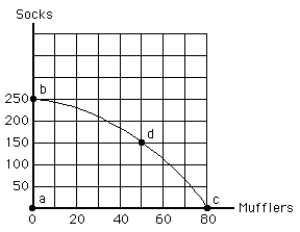 -In Exhibit 2-5, if society moves from point c to point d, society
-In Exhibit 2-5, if society moves from point c to point d, society
A) gains 100 socks
B) loses 30 mufflers
C) is worse off after the change in production
D) is not operating efficiently
E) experiences some unemployment of resources
Correct Answer

verified
Correct Answer
verified
Multiple Choice
Adam Smith's term, "the invisible hand," refers to
A) the hidden role of government in setting regulations that govern trading in markets
B) the most capable entrepreneurs in the economy
C) market forces
D) the unseen work of the financial markets that facilitates trade
E) the role of technological change and random events in the economy
Correct Answer

verified
Correct Answer
verified
Multiple Choice
Exhibit 2-9 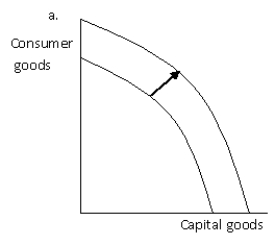
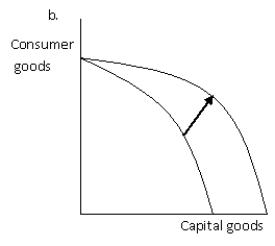
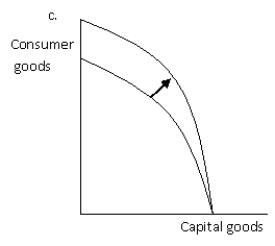
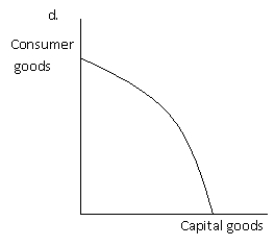 -Refer to Exhibit 2-9. Which of the graphs best illustrates the impact on the production possibilities frontier of a dramatic increase in the rate of immigration into a country?
-Refer to Exhibit 2-9. Which of the graphs best illustrates the impact on the production possibilities frontier of a dramatic increase in the rate of immigration into a country?
A) a
B) b
C) c
D) d
E) b and c
Correct Answer

verified
Correct Answer
verified
Multiple Choice
Opportunity cost exists because
A) technology is fixed at any point in time
B) the law of comparative advantage is working
C) resources are scarce but wants are unlimited
D) the value of lost opportunities varies from person to person
E) efficiency is measured by the monetary cost of an activity
Correct Answer

verified
Correct Answer
verified
Multiple Choice
People have less incentive to invest the more concerned they are that their investment will not be
A) appropriated by government
B) stolen by thieves
C) protected from high tax rates
D) destroyed by civil unrest
E) blown up by terrorists
Correct Answer

verified
Correct Answer
verified
True/False
Exhibit 2-2
 -Specialization can sometimes create problems such as boredom and repetitive motion injuries.
-Specialization can sometimes create problems such as boredom and repetitive motion injuries.
Correct Answer

verified
Correct Answer
verified
Multiple Choice
Points inside the production possibilities frontier represent
A) full and efficient use of all resources
B) inefficiency or unemployment (or both)
C) currently unattainable combinations of outputs
D) currently unattainable combinations of resources
E) the most desirable combinations of outputs
Correct Answer

verified
Correct Answer
verified
Multiple Choice
Exhibit 2-3 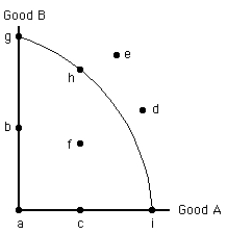 -In Exhibit 2-3, if resources are used fully and efficiently, then the economy can produce at point(s)
-In Exhibit 2-3, if resources are used fully and efficiently, then the economy can produce at point(s)
A) f
B) h, d, or e
C) a, b, or c
D) d or e
E) g, h, or i
Correct Answer

verified
Correct Answer
verified
Multiple Choice
An improvement in technology would
A) enable the economy to produce outside its original production possibilities frontier
B) enable the economy to move along its original production possibilities frontier
C) eliminate scarcity; therefore, the production possibilities frontier would no longer exist
D) have no effect on the production possibilities frontier
E) change the production possibilities frontier to a line with a positive slope
Correct Answer

verified
Correct Answer
verified
Multiple Choice
Exhibit 2-2
 -Division of labor increases productivity because
-Division of labor increases productivity because
A) tasks can be assigned according to individual tastes and abilities
B) workers who repeatedly perform the same tasks become bored
C) each worker must learn each of the numerous tasks in the total production process
D) specialization of labor allows for the introduction of cheaper, less sophisticated production techniques
E) managers can force workers to produce goods that are valued more highly than the costs of producing them.
Correct Answer

verified
Correct Answer
verified
True/False
The production possibilities frontier represents all desirable combinations of two goods
Correct Answer

verified
Correct Answer
verified
Multiple Choice
If the production possibilities curve is a downward-sloping straight line, that would indicate
A) that society cannot decide which good it prefers
B) an absence of scarcity
C) constant opportunity cost
D) inefficiency
E) specialization
Correct Answer

verified
Correct Answer
verified
Multiple Choice
Along a bowed-out production possibilities frontier, as more of one good is produced,
A) the opportunity cost of producing that good remains constant
B) the opportunity cost of producing that good decreases
C) efficiency decreases
D) the opportunity cost of producing both goods must remain constant
E) technology remains constant
Correct Answer

verified
Correct Answer
verified
Multiple Choice
In one week, Mohammed can knit 5 sweaters or bake 240 cookies. In one week, Tetah can knit 15 sweaters or bake 480 cookies. In this example,
A) Mohammed has the absolute and comparative advantage in both tasks
B) Tetah has the absolute and comparative advantage in both tasks
C) Mohammed has the absolute advantage in both tasks and the comparative advantage in knitting sweaters
D) Tetah has the absolute advantage in both tasks and the comparative advantage in knitting sweaters
E) Mohammed has the absolute advantage in both tasks and the comparative advantage in baking cookies
Correct Answer

verified
Correct Answer
verified
Showing 121 - 140 of 195
Related Exams